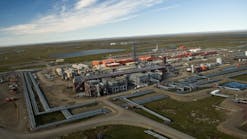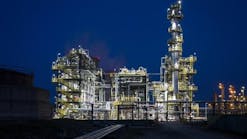The peaks and valleys seen in oil prices the past 4 years offer insight into lessons learned in the oil price downturn of 1998-99 and future demand trends in the US market, says the Federal Reserve Bank in Dallas.
Writing in the bank's June Houston business report, Senior Economist, Bill Gilmer, contends that, after the 12 months of low oil prices following March 1998, the industry should rewrite its rule of thumb that oil prices will never fall below $15/bbl.
The main lesson the industry learned from these swings, Gilmer says, is that too many companies focused on the record revenues and backlogs of work of 1997 and used these factors in making long-term decisions concerning staffing and equipment.
"If we adjust for inflation and examine the average quarterly price for crude oil after 1984, 5 of the 6 worst quarters of the past 15 years came in 1998 and early 1999," says Gilmer, adding that the infamous third quarter of 1986 now ranks eighth from the bottom.
A 4-year journey
The recent surge in oil prices completes the cycle begun 4 years ago, says Gilmer, when the price of West Texas Intermediate was holding steady at $20-21/bbl in mid-1996, supported by strong economic expansion in the US and around the world. At that time, drilling activity was strong and building, with 775 rigs at work in the US. But by early 1997, as the industry expanded from 800 to 900 working rigs, capacity constraints were felt, and severe shortages developed for drilling crews, drill pipe, offshore rigs, and geophysical skills.
"The exchange of Iraqi crude for humanitarian supplies finally began in December 1996, and the 800,000 b/d "was being absorbed with barely a ripple," said Gilmer. Long-term retention bonuses became a common tool to keep crucial technical skills in a "red-hot" labor market, and conferences focused on how to attract people into the industry.
The Baker Hughes Inc. US rig count rose throughout 1997, peaking at 1,032 in September and remaining above 1,000 through December.
The Asian crisis caused no immediate impact on the world oil markets during the summer of 1997, but by autumn, slowing Asian growth was putting oil back into the world markets. The price of spot WTI slipped under $20/bbl on Nov. 17, 1997, a level it wouldn't revisit for another 20 months.
Prices continued to collapse in 1998, with crude falling to $16/bbl in January 1998, $15/bbl in February, and finally, under $12/bbl in June. With US crude oil inventories 6% above levels seen the previous year, the Organization of Petroleum Exporting Countries failed miserably in an effort that April to remove oil from markets and jump-start prices, writes Gilmer. After falling below $12, the price continued to hold at $12-14/bbl for the next 9 months.
The rig count slipped below 900 in March 1998 and had fallen below 800 by September. International rig counts hit all-time lows in late 1998, and, for the first time in the history of the Baker Hughes rig count, the number of rigs working in the US fell below 500 in April 1999.
In March 1999, OPEC succeeded in its second try to raise prices. Joined by non-OPEC producers Mexico and Norway, Saudi Arabia agreed to take its first formal loss in market share since the Persian Gulf War. Spot WTI was selling for $12.53/bbl on Mar. 1 but quickly climbed back above $20/bbl, due to OPEC compliance with the cutback agreement and the return of strong global economic expansion.
Strong demand for gasoline during the summer of 1999 eventually drove crude oil prices up to $30/bbl. This spring, OPEC members agreed to add 1.45 million b/d to world markets amid concerns that oil prices topping $30/bbl could undermine the worldwide economic expansion that supported the price rise, Gilmer says.
The US rig count is again above 860 working rigs as the drilling market recovers, completing the cycle begun in 1996.
Shift to natural gas
The latest downturn accelerated the dominance of natural gas in the US drilling market, as gas prices were increasingly isolated from the world oil cycle. The large fraction of US drilling devoted to natural gas instead of oil demonstrates a distrust of OPEC, says Gilmer.
Gas prices proved the positive surprise in the latest cycle of world oil markets. Gilmer says gas prices have generally remained above $2/Mcf since 1996. While oil prices collapsed in spring 1998, "gas prices barely flinched," briefly falling under $2 before reviving with strong summer demand for electricity generation.
Warm winter weather in spring 1999 led to the longest recent period of gas prices below $2, but gas hasn't fallen under $2 since then. Fuel switching in 1998-99 probably took place as gas prices eclipsed oil, but environmental restrictions on burning oil is limiting fuel switching. And the traditionally weak gas demand seen in the spring and autumn months is getting a boost from power generation.
Lessons learned
From these latest swings in world oil markets, says Gilmer, the industry should learn "first, that linear thinking is going to get you into trouble, and extrapolating the present into the future never works. It was the unforeseeable event, a financial crisis in Asia, that sent oil markets tumbling," he said.
"Finally, what about OPEC's return to the driver's seat in world oil markets? Can we assume oil prices are on a permanent high plateau, thanks to OPEC's newly found unity?
"Contrast OPEC's floundering efforts to revive oil prices in March and April 1998-just as crude prices collapsed completely-with its remarkable success only 12 months later. Holding the last barrels of crude to be delivered to market, OPEC can look potent at the top of the cycle, but whether cartel unity alone can provide a floor to oil prices without substantial help from the world economy is still open to question."


